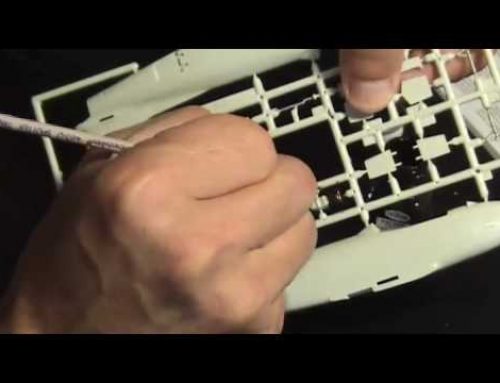As part of the 1/144 Spaceship Model Projects, I needed to start testing paints. Back when I was first learning how to airbrush, there wasn’t a lot of choice when it came to model paints. It was basically enamels and, if you weren’t faint of heart, lacquers. Either way, you were looking at spending a fair amount of time breathing in fumes you really shouldn’t be breathing. (This was also a time before respirators were common.)
Today, there are a variety of water-borne acrylic paints that are welcome options. One of the common brands in use is Tamiya. While water-borne, this paint uses alcohol as its solvent. I figured that as long as I was going to do a quick test with this paint designed for plastic models, I might as well test the paints I use in my art: E’tac.
The Test
For the support I used a piece of sheet styrene and wiped it down to remove grease and any other surface impurities. All colors were sprayed with an Iwata
I let these strips dry overnight. I then applied some
You can see scratch marks. I made those with my thumbnail to see how delicate the paint was. Amazingly, the red was the toughest of the lot, though not by much.
At this point I painted white over the swatches to test coverage. The top white is Tamiya thinned with IPA, the lower strip is E’tac white with H2Uro. I was surprised that the Tamiya wasn’t able to reach the same degree of opacity as E’tac. It probably would if I applied more paint, but then it would start to build up.
I again applied Tamiya tape over the white for a couple of hours. When removed, the results were similar to before: the orange came up easily as did some patches of the red. This was the second application of tape for some areas and I have to say they held up well.
Finally, I did another scratch test down both of the white stripes. The E’tac stripe was slightly more delicate and showed some evidence of ripping instead by being cut by my nail.
Initial Conclusions
E’tac paint showed admirably but certain colors can be problematic. Tests need to be done before use on an actual model. The Tamiya sample was small, but it performed as you’d expect from a paint designed for this purpose. If a mistake needs to be painted over, I’d be comfortable using E’tac’s white for the job. It adheres well and reaches opacity fairly quickly…though caution must be exercised lest it build-up too much.
A few more colors should be tested from both brands and I need to also test the E’tac PS series as well. Tests also need to be made with various undercoats (primers, Future) and using Future as an intercoat/topcoat.
The Tamiya tape lives up to its billing. It holds well but not too well. Though a bit pricier than other tapes, it seems to be more than worth it.



